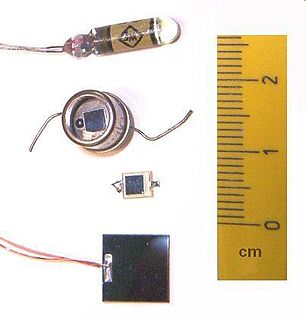
Transistor testers are instruments for testing the electrical behavior of transistors and solid-state diodes. [1]

Transistor testers are instruments for testing the electrical behavior of transistors and solid-state diodes. [1]
There are three types of transistor testers each performing a unique operation.
In addition, curve tracers are reliable indicators of transistor performance.
A circuit tester is used to check whether a transistor which has previously been performing properly in a circuit is still operational. The transistor's ability to "amplify" is taken as a rough index of its performance. This type of tester indicates to a technician whether the transistor is dead or still operative. The advantage of this tester is that the transistor does not have to be removed from the circuit.
These devices usually perform three types of checks:
Some service testers include a go/no-go feature, indicating a pass when a certain hfe is exceeded. These are useful, but fail some functional but low hfe transistors.
Some also provide a means of identifying transistor elements, if these are unknown. The tester has all these features and can check solid-state devices in and out of circuit.
Transistor hfe varies fairly widely with Ic, so measurements with the service type tester give readings that can differ quite a bit from the hfe in the transistor's real life application. Hence these testers are useful, but can't be regarded as giving accurate real-life hfe values.
This type of tester is used for measuring transistor parameters dynamically under various operating conditions. The readings they give are absolute. Among the important characteristics measured are:
Transistor testers have the necessary controls and switches for making the proper voltage, current and signal settings. A meter with a calibrated "good" and "bad" scale is on the front. In addition, these transistor testers are designed to check the solid-state diodes. There are also testers for checking high transistor and rectifiers.

An amplifier, electronic amplifier or (informally) amp is an electronic device that can increase the power of a signal. It is a two-port electronic circuit that uses electric power from a power supply to increase the amplitude of a signal applied to its input terminals, producing a proportionally greater amplitude signal at its output. The amount of amplification provided by an amplifier is measured by its gain: the ratio of output voltage, current, or power to input. An amplifier is a circuit that has a power gain greater than one.

A transistor is a semiconductor device used to amplify or switch electronic signals and electrical power. It is composed of semiconductor material usually with at least three terminals for connection to an external circuit. A voltage or current applied to one pair of the transistor's terminals controls the current through another pair of terminals. Because the controlled (output) power can be higher than the controlling (input) power, a transistor can amplify a signal. Today, some transistors are packaged individually, but many more are found embedded in integrated circuits.
A semiconductor device is an electronic component that relies on the electronic properties of a semiconductor material for its function. Semiconductor devices have replaced vacuum tubes in most applications. They use electrical conduction in the solid state rather than the gaseous state or thermionic emission in a vacuum.

A multimeter or a multitester, also known as a VOM (volt-ohm-milliammeter), is an electronic measuring instrument that combines several measurement functions in one unit. A typical multimeter can measure voltage, current, and resistance. Analog multimeters use a microammeter with a moving pointer to display readings. Digital multimeters have a numeric display, and may also show a graphical bar representing the measured value. Digital multimeters are now far more common due to their lower cost and greater precision, but analog multimeters are still preferable in some cases, for example when monitoring a rapidly varying value.

A photodiode is a semiconductor device that converts light into an electrical current. The current is generated when photons are absorbed in the photodiode. Photodiodes may contain optical filters, built-in lenses, and may have large or small surface areas. Photodiodes usually have a slower response time as their surface area increases. The common, traditional solar cell used to generate electric solar power is a large area photodiode.

A bipolar junction transistor is a type of transistor that uses both electrons and holes as charge carriers.

A Zener diode is a type of diode that allows current to flow in the conventional manner - from its anode to its cathode i.e. when the anode is positive with respect to the cathode. When the voltage across the terminals is reversed and the potential reaches the Zener voltage, the junction will breakdown and current will flow in the reverse direction - a desired characteristic. This effect is known as the Zener effect, after Clarence Zener, who first described the phenomenon. Zener diodes are manufactured with a great variety of Zener voltages (Vz) and some are even variable.
A unijunction transistor (UJT) is a three-lead electronic semiconductor device with only one junction that acts exclusively as an electrically controlled switch.

In electronics, a multi-transistor configuration called the Darlington configuration is a compound structure of a particular design made by two bipolar transistors connected in such a way that the current amplified by the first transistor is amplified further by the second one. This configuration gives a much higher current gain than each transistor taken separately. It was invented in 1953 by Sidney Darlington.
In electronics, a linear regulator is a system used to maintain a steady voltage. The resistance of the regulator varies in accordance with the load resulting in a constant voltage output. The regulating device is made to act like a variable resistor, continuously adjusting a voltage divider network to maintain a constant output voltage and continually dissipating the difference between the input and regulated voltages as waste heat. By contrast, a switching regulator uses an active device that switches on and off to maintain an average value of output. Because the regulated voltage of a linear regulator must always be lower than input voltage, efficiency is limited and the input voltage must be high enough to always allow the active device to drop some voltage.
Resistor–transistor logic (RTL) is a class of digital circuits built using resistors as the input network and bipolar junction transistors (BJTs) as switching devices. RTL is the earliest class of transistorized digital logic circuit used; other classes include diode–transistor logic (DTL) and transistor–transistor logic (TTL). RTL circuits were first constructed with discrete components, but in 1961 it became the first digital logic family to be produced as a monolithic integrated circuit. RTL integrated circuits were used in the Apollo Guidance Computer, whose design was begun in 1961 and which first flew in 1966.

A current source is an electronic circuit that delivers or absorbs an electric current which is independent of the voltage across it.

The breakdown voltage of an insulator is the minimum voltage that causes a portion of an insulator to become electrically conductive.

An electronic component is any basic discrete device or physical entity in an electronic system used to affect electrons or their associated fields. Electronic components are mostly industrial products, available in a singular form and are not to be confused with electrical elements, which are conceptual abstractions representing idealized electronic components.
An avalanche transistor is a bipolar junction transistor designed for operation in the region of its collector-current/collector-to-emitter voltage characteristics beyond the collector-to-emitter breakdown voltage, called avalanche breakdown region. This region is characterized by avalanche breakdown, which is a phenomenon similar to Townsend discharge for gases, and negative differential resistance. Operation in the avalanche breakdown region is called avalanche-mode operation: it gives avalanche transistors the ability to switch very high currents with less than a nanosecond rise and fall times. Transistors not specifically designed for the purpose can have reasonably consistent avalanche properties; for example 82% of samples of the 15V high-speed switch 2N2369, manufactured over a 12-year period, were capable of generating avalanche breakdown pulses with rise time of 350 ps or less, using a 90V power supply as Jim Williams writes.
A Wilson current mirror is a three-terminal circuit that accepts an input current at the input terminal and provides a "mirrored" current source or sink output at the output terminal. The mirrored current is a precise copy of the input current. It may be used as a Wilson current source by applying a constant bias current to the input branch as in Fig. 2. The circuit is named after George R. Wilson, an integrated circuit design engineer who worked for Tektronix. Wilson devised this configuration in 1967 when he and Barrie Gilbert challenged each other to find an improved current mirror overnight that would use only three transistors. Wilson won the challenge.

In graphical analysis of nonlinear electronic circuits, a load line is a line drawn on the characteristic curve, a graph of the current vs. the voltage in a nonlinear device like a diode or transistor. It represents the constraint put on the voltage and current in the nonlinear device by the external circuit. The load line, usually a straight line, represents the response of the linear part of the circuit, connected to the nonlinear device in question. The points where the characteristic curve and the load line intersect are the possible operating point(s) of the circuit; at these points the current and voltage parameters of both parts of the circuit match.

Bipolar transistors must be properly biased to operate correctly. In circuits made with individual devices, biasing networks consisting of resistors are commonly employed. Much more elaborate biasing arrangements are used in integrated circuits, for example, bandgap voltage references and current mirrors. The voltage divider configuration achieves the correct voltages by the use of resistors in certain patterns. By selecting the proper resistor values, stable current levels can be achieved that vary only little over temperature and with transistor properties such as β.

A tube tester is an electronic instrument designed to test certain characteristics of vacuum tubes. Tube testers evolved along with the vacuum tube to satisfy the demands of the time, and their evolution ended with the tube era. The first tube testers were simple units designed for specific tubes to be used in the battlefields of World War I by radio operators, so they could easily test the tubes of their communication equipment.

A Schottky transistor is a combination of a transistor and a Schottky diode that prevents the transistor from saturating by diverting the excessive input current. It is also called a Schottky-clamped transistor.